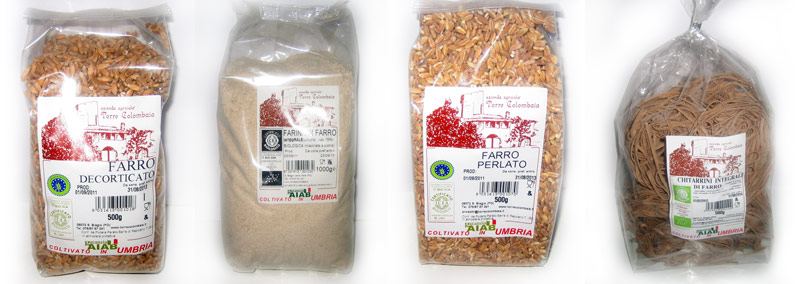OUR GROWING METHOD
Spelt is one of the most ancient cereals: already cultivated 12,000 years ago in the Middle East (the Fertile Crescent).
After ploughing or ripping and then extirpating (to get smaller plates) the ground, after the previous threshing, at the beginning of November, we sow about 2 hundred kilograms of well selected seeds per hectare.
The seed is ours, from the previous year’s crop.
Variety is the Triticum dicoccum. We took it years ago from Garfagnana and we have always reseeded ours.
Then we fertilize with 10 tons of manure cover per hectare, going over the land in January-February with the harrow tines to mechanically pull up (without the use of chemical herbicide) newborn weeds with mini-leaves without damaging the already 10 centimetres high wheat.
Finally, in early July we thresh and put wheat in the silo, sealed under nitrogen for 48 hours, to kill larvae and eggs of possible bugs.
Spelt is a cereal generous and rustic at the same time. It resists better than other cereals to adverse weather conditions, drought, and weeds, dominating from its height of 1.50 meters.
TRANSFORMATION
Being a covered cereal (i.e. with external glumes) it cannot be consumed as it is. After threshing and silage, we send it to a hulling plant, where we collect it (with a yield of approximately 60%) as hulled or pearl spelt.
Hulled spelt is virtually whole (it should be soaked overnight before cooking). While if it is pearl spelt, part of the edible hull is removed from the grain therefore losing some of its properties, but it does not need to be soaked before cooking.
Next, to get the whole flour, we mill it with our wood stone mill, manufactured in Austria.
In order to obtain type “0” flour, we must bring our grain to the biological cylinders mill outside our farm.
Finally, to keep this flour, we put them in 10 or 25 kg sacks and store them in our cell-fridge.
To obtain spelt pasta (chitarrini) we bring our whole flour to a slow drying pasta factory.
Finally, for spelt cakes, we bring pearl barley to a small local plant that “blows” and bundles it, with no added salt or otherwise.
BENEFITS
Spelt contains a smaller amount of gluten compared to wheat. It has more ashes, many more minerals, a higher protein and fibre content, still compared to wheat.
It is also an important source of natural antioxidants. No coincidence, it is recommended by St. Hildegard of Bingen since 1200 for its healing properties.

